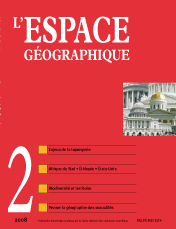

The making of place names a new contextual and interpretative approach
We propose a general framework for both contextualisation and interpretation of contemporary toponymy. It is based on three different types of territorial restructuring that go with new place names: revolution, restitution and construction. In the revolutionary type, both territorial and toponymic, the eradication of previous forms is the preferred action. Restitution to dominated minorities and cultures emphasises practices of identity restoration. During the construction of new territories, practices highlighting heritage and image resources are preferred. Lastly, this paper examines, through different national situations, how these three types can be combined, and the contradictions that are thus revealed.
keywords: DENTITY, ONOMASTIC, PLACE NAME, TERRITORIAL RESTRUCTURING, TOPONYMY
(Re)naming American state capitals: toponymy as a maker of the construction of an Empire’s identity (3 fig., 1 photo, 3 tabl.)
American State capitals, a type-case of new countries that combine withdrawal from an empire with empire creation, show the two sides of neotoponymy: removing the old name and creating a new name. The long timeline of the processes leads to a mix of foreign and domestic references. Today’s toponymical palimpsest alludes to different scales and actors, between local aspirations, geo-marketing, and national geopolitics. Pre-colonial toponymy was kept and the restoration of native toponyms is no longer an issue. The toponymical stability since the end of 19th century might thus be one of the last bastions of the initial geopolitical construct.
keywords: EMPIRE, GEO-MARKETING, IDENTITY CONSTRUCTION, NEOTOPONYMY, PRE-COLONIAL TOPONYMY
“Whatsoever the man called each one, that was the namethereof”: place name policy in Ethiopia (2 fig.)
Ethiopia was never colonised and has never experienced any post-colonial “toponymic cleansing”. The Marxist and atheist revolution did not deeply change place names in the country. Ethiopian toponyms have been borrowed from Eastern Christian topography. From the restoration of the Solomonic dynasty (XIIIth century) to the reign of Menelik II (1889-1913), all the Ethiopian kings claimed that Ethiopia was the Holy Land and the Ethiopians the Chosen People. Biblical place names are linked to the expansion or contraction of the Christian realm. Since the proclamation of the 1994 federal constitution, regionalist movements have called for a return to indigenous place names.
keywords: CHURCH, ETHIOPIA, ETHNOFEDERALISM, MENELIK II, REVOLUTION
Words at stake: changing place names in South Africa (2 encadrés, 3 fig., 2 photos, 2 tabl.)
On a long timeline, the issue of place names in South Africa can be divided into two key themes: firstly, multilingualism and the hierarchy of local languages (with arguments around their respective superiority, antecedence or operationality); secondly, the symbolic and memorial marking of the territory via icons of the various struggles in South Africa’s past. Issues of language and memory overlap, and are often instrumentalised together by a given community. This paper suggests that toponymic choices deal with more than these issues of recognition and precedence between cultures and histories. Toponyms, their choice and the debates about them, reflect how specific places strive for autonomy or a new role in place hierarchy from local to global. In turn, place hierarchy indicates the relationships between the different South African communities, also expressed in toponymy.
keywords: APARTHEID, PLACE NAME, SOUTH AFRICA, TERRITORIAL RESTRUCTURING, TOPONYMY
Local territory and biodiversity dynamics. A case study of functional scale in coastal Guinea (4 fig.)
Considering biodiversity merely as a list of endangered species is to take a narrow view. Biodiversity is a dynamic process, resulting from complex ecological interactions and interactions with human societies on various scales. Understanding how human beings interact with biodiversity dynamics requires describing the links and identifying relevant scales, where the integration of ecological process with social facts is meaningful. A case study in coastal Guinea explores the links between local territory and ecological landscape, showing how this socio-spatial entity could be described as a functional scale in biodiversity dynamics.
keywords: BIODIVERSITY, GUINEA, TERRITORY
Elements for a queer geography (1 fig., 1 encadré)
This paper examines the recent growth of work in the field of geography of gender and sexuality in France. It’s focus on epistemology and methodology in a context of pluridisciplinarity. The author indicates that sexuality has become a new area of interest within social and cultural geography. The article criticises the myth of gay liberation and suggests that we need to move away from simply mapping the urban gay village, commercial scene and sexual space. The author proposes a new focus on distance as a way to question normativity.
keywords: DISTANCE, EPISTEMOLOGY, GENDER, HOMOSEXUALITY, SEXUALITY
Book reviews
In this issue of l’Espace géographique, you will find critical reviews of the following books
COURADE G. (dir.) (2005). L’Afrique des idées reçues. Paris: Éditions Belin, coll. «Mappemonde», 400 p. (Benoît ANTHEAUME, IRD Paris)
STAN S. (2005). L’Agriculture roumaine en mutation. La Construction sociale du marché. Paris: CNRS Éditions, 118 p. (Violette REY, ENS Lettres et Sciences humaines, Lyon)
MARSILY G. de (dir.) (2006). Les Eaux continentales. Paris: Institut de France, Académie des sciences, Éditions EDP Sciences, 328 p. (Pierre USSELMANN, CNRS Montpellier)
L’espace géographique 1/08![]()
![]() L’espace géographique 3/08
L’espace géographique 3/08
For subscribe or buy this issue: BELIN
![]() L’Espace géographique: contents
L’Espace géographique: contents
Last modified: June 19, 2008